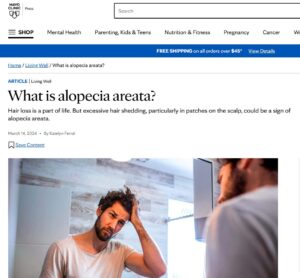The Mayo Clinic Press article “What Is Alopecia Areata?” offers a clear and accessible overview of this autoimmune condition that causes hair loss. Alopecia areata occurs when the immune system mistakenly attacks hair follicles, leading to hair falling out in small, round patches—most often on the scalp, but sometimes affecting the beard, eyebrows, eyelashes, or other areas of the body.
The article explains that while the exact cause is not fully understood, genetic and environmental factors are believed to play a role in triggering the condition. Stress and illness can sometimes precede the onset of symptoms, though these are not considered direct causes. It also notes that alopecia areata can affect anyone, regardless of age or gender, and often begins in childhood or young adulthood.
This guide emphasizes that the amount and pattern of hair loss varies from person to person. Some may experience only a few patches of hair loss, while others may progress to more widespread loss, such as alopecia totalis (complete scalp hair loss) or alopecia universalis (complete loss of all body hair). Importantly, the condition is non-scarring, meaning hair follicles remain intact, allowing for the potential of regrowth.
The article outlines common treatment options, including corticosteroid injections, topical immunotherapy, and newer therapies like JAK inhibitors that are showing promise. While there is currently no cure, many people experience cycles of hair loss and regrowth.
The Mayo Clinic Press also highlights the emotional and psychological impact of alopecia areata, encouraging readers to seek support from healthcare providers, counselors, or peer support groups.
This article serves as a helpful introduction for individuals newly diagnosed or seeking to better understand alopecia areata. With a blend of expert insight and compassionate tone, it provides both clarity and hope.



